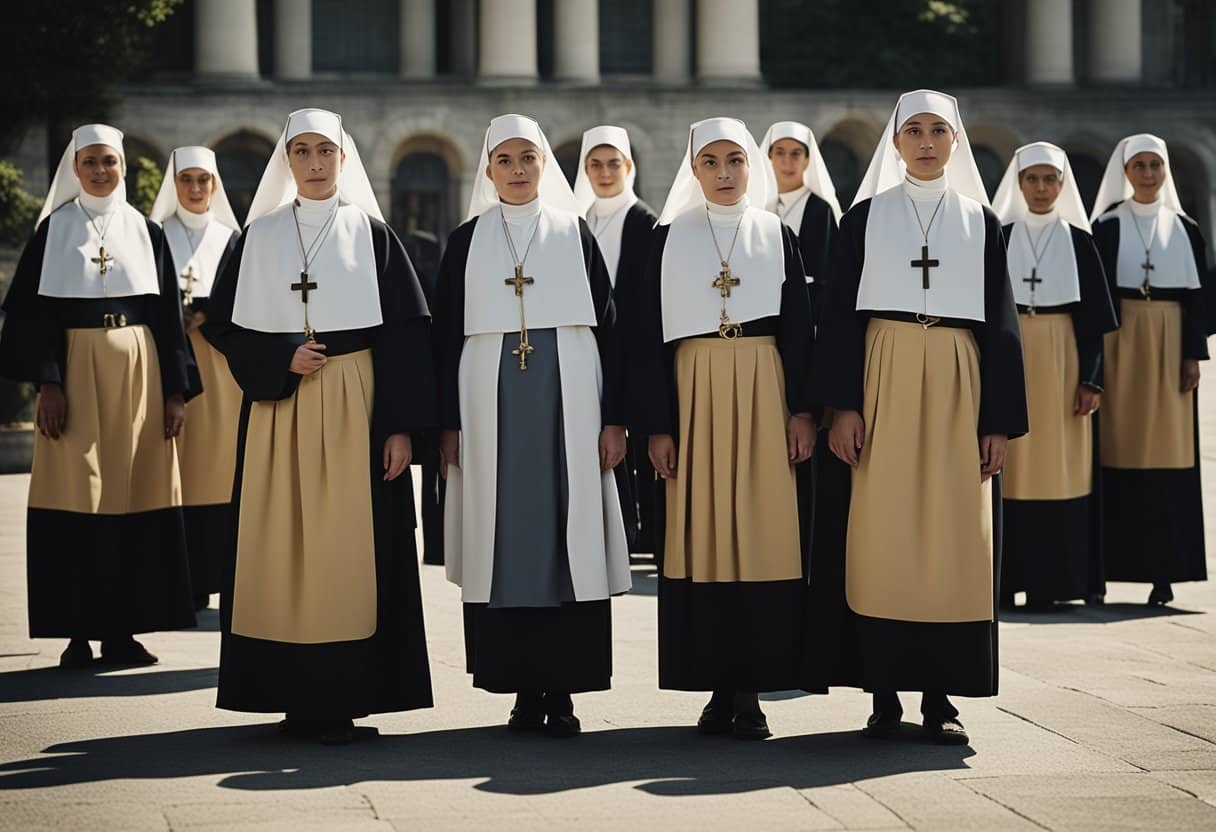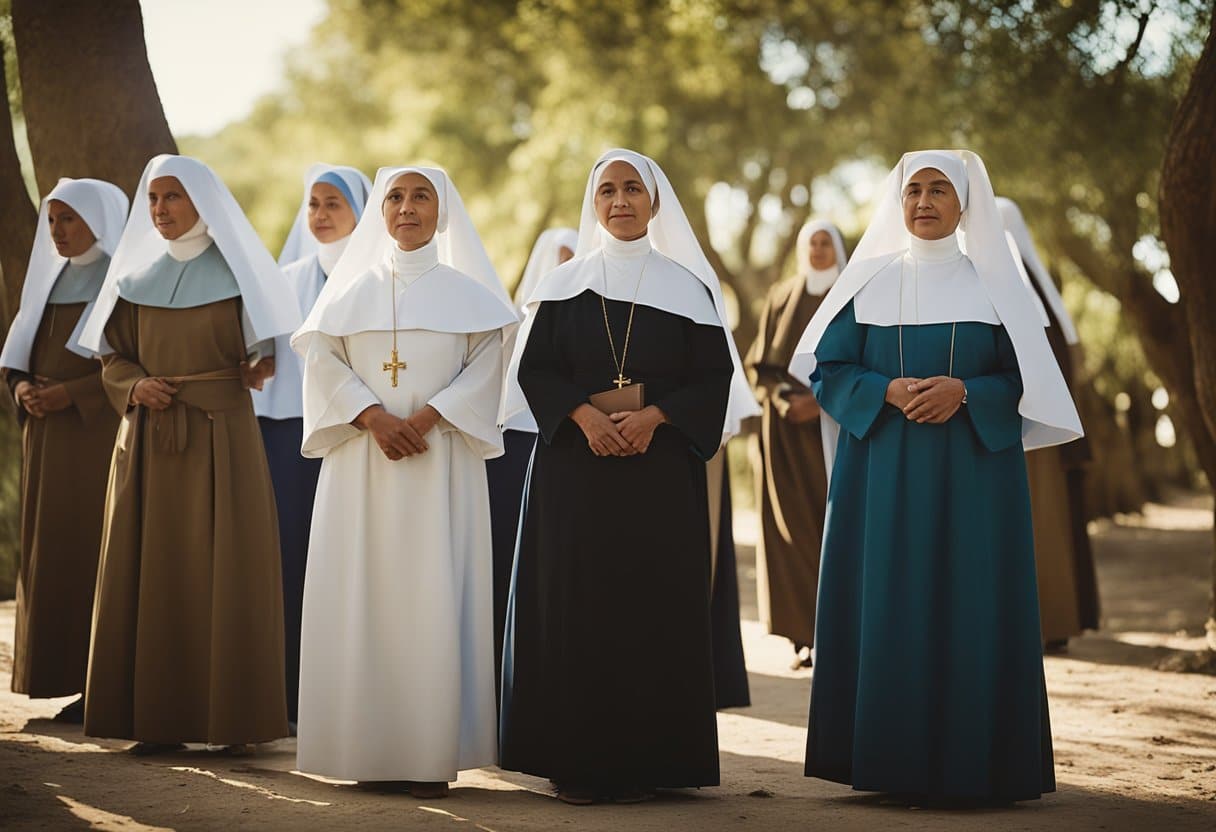As someone who grew up in a Catholic household, I’ve always been curious about the habits that nuns wear.
I’ve seen nuns wearing different colors, and I’ve always wondered why.
After doing some research, I found that there are several reasons why do nuns wear different colors, and it’s not just for fashion.

Nuns belong to different orders, and each order has its own habit, which is a distinctive type of clothing that they wear.
The habit is a symbol of the nun’s devotion to God and a reminder of the vows they have taken.
The different colors of the habits help to differentiate the nuns from different orders.
The symbolism of the habit goes beyond just the color. Each part of the habit has a specific meaning.
For instance, the veil represents the nun’s consecration to God, while the scapular represents the yoke of Christ. The habit is a constant reminder to the nuns of their commitment to God and their community.
Origins of Nun’s Habits

I have always been fascinated by the different colors and styles of habits worn by nuns.
After some research, I discovered that the origin of the nun’s habit dates back to the early days of Christianity.
The habit was originally a simple tunic and veil, worn by both men and women who had dedicated their lives to serving God.
Over time, the habit evolved into a more distinctive form of dress, with different colors and styles worn by different religious orders.
Each order has its own founder and unique traditions, which are reflected in the design and color of their habit.
The habit serves as a symbol of a nun’s commitment to a life of poverty, chastity, and obedience. It also serves as a way to identify the order to which a nun belongs.
While the habit may seem outdated to some, it remains an important part of the Catholic Church and other religious orders.
It serves as a reminder of the sacrifices made by those who dedicate their lives to serving God and others.
In conclusion, the origins of the nun’s habit can be traced back to the early days of Christianity.
The habit has evolved over time to become a distinctive form of dress worn by nuns in different orders.
Despite its simplicity, the habit remains an important symbol of a nun’s commitment to a life of service and sacrifice.
Symbolism and Significance
As a nun, the habit I wear is a symbol of my dedication to my faith and my community.
The colors of the habit are not chosen at random, but rather each color has its own symbolism and significance.
The most common color for nuns to wear is black, which symbolizes death to the world and penitence.
The black habit is also practical, as it was the cheapest fabric available during the sixth century.
White is another common color, and it represents purity and holiness. Nuns who wear white habits often belong to orders that focus on prayer and contemplation.
Red is a color that is sometimes worn by nuns, and it represents the divine. It is often used in conjunction with a white habit, and it is associated with orders that focus on service and charity work.
In addition to the color of the habit, there are other elements that are significant.
The cross that is worn by many nuns is a symbol of Christ’s sacrifice, and it serves as a reminder of the nun’s commitment to her faith.
The cincture, or rope belt, that is worn around the waist is a symbol of chastity and poverty.
The habit is also an important element of hierarchy within a convent.
But, why do nuns wear different colors? The different colors and styles of the habit indicate the rank of the nun within the community.
This helps to create a recognizable and organized community, which is important for the functioning of the convent.
Overall, the habit worn by nuns is a symbol of their dedication to their faith and their community.
The colors and elements of the habit have specific meanings that reflect the values and beliefs of the order to which the nun belongs.
Variations in Habit Colors

As a nun, the habit is an essential part of my identity. The habit’s color can indicate the order of nuns to which I belong, my position within the order, or the occasion for which I am wearing it.
The most common color for a nun’s habit is black, signifying humility and penance. However, other colors are also used, such as white, blue, brown, and gray.
These colors can represent specific orders, such as the blue habit of the Daughters of Charity of Saint Vincent de Paul, or the brown habit of the Franciscan Sisters of the Immaculate Conception.
The habit’s design can also vary, with some orders wearing a simple tunic and scapular, while others wear a more distinctive garb, such as a blue cape or a brown belt.
The head covering, or veil can also differ in style, with some orders wearing a full veil that covers the face, while others wear a simple head covering.
The habit’s color and design can also indicate a nun’s position within the order. For example, a novice may wear a simple habit, while a professed nun may wear a more elaborate one.
The color and design can also change depending on the occasion. For example, a nun may wear a white habit for special celebrations, such as the Feast of the Immaculate Conception.
In conclusion, the color and design of a nun’s habit can convey a wealth of information about her order, position, and occasion.
While the habit’s color and design can vary, it is always a symbol of a nun’s dedication to her faith and her community.
Role of Habits in Religious Life

As a Catholic nun, my habit is an essential part of my life. It serves as a symbol of my consecration to Christ and my commitment to live a life of poverty, chastity, and obedience.
The habit represents my devotion to God and my vocation to serve Him.
The habit is not just a piece of clothing; it is a sign of my faith and my identity as a religious sister. It reminds me of the importance of living a simple life, free from worldly possessions and distractions.
By wearing the habit, I am constantly reminded of my mission to serve Christ and His people.
The habit also serves as a reminder of the vows I have taken. As a religious sister, I have made solemn vows of poverty, chastity, and obedience.
These vows are a sign of my commitment to live a life of simplicity and devotion to Christ.
While the habit is an important part of my life, it is not the most important thing. The most important thing is my relationship with Christ.
The habit is simply a tool to help me grow closer to Him and to serve Him more faithfully.
In conclusion, the habit plays a significant role in the life of a Catholic nun.
It serves as a symbol of her consecration to Christ and her commitment to live a life of poverty, chastity, and obedience. It reminds her of the importance of living a simple life and of her mission to serve Christ and His people.
However, the habit is not the most important thing. The most important thing is her relationship with Christ and her commitment to serve Him faithfully.
Notable Orders and Their Habits

As mentioned earlier, different orders of nuns wear different colored habits to differentiate themselves from one another. Here are some of the most notable orders and their habits:
Benedictines
Benedictine nuns wear a black habit with a white wimple and veil.
The black habit represents their commitment to mourning and penance, while the white wimple and veil symbolize their purity and devotion to God.
Carthusians
Carthusian nuns wear a white habit with a black scapular.
The white habit represents their purity and devotion to God, while the black scapular symbolizes their commitment to penance and self-denial.
Poor Clares
Poor Clare nuns wear a brown habit with a white veil. The brown habit represents their commitment to poverty, while the white veil symbolizes their purity and devotion to God.
Eastern Orthodox
In the Eastern Orthodox Church, nuns wear a black habit with a veil and headscarf.
The black habit represents their commitment to mourning and penance, while the veil and headscarf symbolize their submission to God.
Deaconesses
Deaconesses in the early Christian Church wore a white alb, which symbolized their purity and devotion to God.
They also wore a stole, which represented their authority as a deaconess.
St. Francis of Assisi
The Franciscan nuns, founded by St. Francis of Assisi, wear a brown habit with a white veil. The brown habit represents their commitment to poverty, while the white veil symbolizes their purity and devotion to God.
Rosary and Mount Carmel
The nuns of the Rosary and Mount Carmel wear a white habit with a black veil.
The white habit represents their purity and devotion to God, while the black veil symbolizes their commitment to mourning and penance.
Cistercian Nuns
Cistercian nuns wear a white habit with a black scapular.
The white habit represents their purity and devotion to God, while the black scapular symbolizes their commitment to penance and self-denial.
Mercedarians
Mercedarian nuns wear a white habit with a white scapular.
The white habit represents their purity and devotion to God, while the white scapular symbolizes their commitment to the redemption of captives.
Nurses
Nurses who are nuns wear a white habit with a white veil. The white habit represents their purity and devotion to God, while the white veil symbolizes their commitment to serving others.
Separation and Death to the World
Nuns who have taken a vow of separation from the world wear a black habit with a white wimple and veil.
The black habit represents their separation from the world, while the white wimple and veil symbolize their purity and devotion to God. Some nuns who have taken a vow of “death to the world” wear a black habit with a white scapular.
The black habit represents their commitment to mourning and penance, while the white scapular symbolizes their purity and devotion to God.
